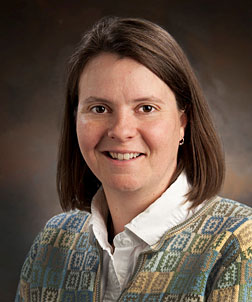- Number 380 |
- January 21, 2013
Savannah River's Kuhne keeps the radioecology flame alive

Dr. Wendy Kuhne of DOE's Savannah River
National Laboratory.
Senior scientist Dr. Wendy Kuhne of DOE's Savannah River National Laboratory has a unique professional niche. A large part of her job involves leadership of an effort to assure that she’s not, literally, the last person left in her field, radioecology.
Kuhne serves as the Director of the SRNL-led National Center for Radioecology, a multi-partner effort that is seeking to maintain and grow the scientific discipline and expertise of radioecology in the United States. The radioecology field encompasses the relationships between radiation or radioactive substances and the environment, including populations, communities, ecosystems, biomes, and even the biosphere.
Her PhD, obtained from Colorado State University in 2006, is in Radiological Health Sciences with a specialty in radioecology. Hers, with the specialty radioecology, was the last degree granted in the last remaining American graduate-level program; the CSU degree program has been no longer available after the retirement of Dr. Ward Whicker, Kuhne’s graduate adviser and a pioneer in the field.
“There are people currently working in the field of radioecology, but many have degrees from other disciplines such as health physics or environmental toxicology. Very few have had the opportunity to formally study radioecology,” she says. “The radioecology community is quite small with probably less than 25 practicing radioecologists remaining in the US. Many who have graduated from the CSU radioecology program have been recruited internationally.”
NCoRE began in 2010, when SRNL signed MOUs and MOAs with six U.S. universities, international organizations in France and the Ukraine, and Savannah River Ecology Laboratory. In addition to serving as a spokesperson for the discipline, much of Kuhne’s effort involves working with partners to identify research priorities, and trying to help reconstitute a graduate-level program, perhaps as a shared curriculum among multiple schools. Clemson, Colorado State, Duke, Oregon State, and South Carolina each are university members, and each has either a history in the discipline or a combination of interest and relevant expertise.
“Research in this field is very fragmented, and may soon be even more hampered by the closure of key infrastructure and the retirement of more expertise,” she said. “There was a perception that we had learned all we needed to know, but it’s clear that there’s still so much that we don’t know about radiation in the environment. Particularly as the nuclear industry continues to mature, we need to move the radioecology field forward to answer questions and use technologies that weren’t available to us 30 to 40 years ago.”
“My generation of researchers needs to make that connection between traditional radioecology – looking at the individual level, the population level and the community level where the primary endpoints were focused on mortality and reproductive effects– to utilizing techniques commonly used in radiation biology to investigate sub-lethal effects occurring at the molecular level. Investigations into the effects of chronic low level radiation on genes, cells, and proteins will be very important as we try to resolve the effects and consequences of legacy contamination.”
NCoRE is gaining momentum, hosting a workshop in late 2012 for more than 60 interested parties from universities, government organizations, and the private sector. That effort helped to identify priorities, both in the academic arena and for highest priority research. NCoRE, Kuhne says, has also gained recognition nationally and internationally as the U.S. contact within the field of radioecology.
Kuhne claims to have entered the field “somewhat by accident.”
After earning a biology degree (via a tennis scholarship) from Catawba College in her home state of North Carolina, she eventually entered a U.S. Geological Survey sponsored Masters program at New Mexico State University in wildlife science. Her project involved depleted uranium, and the hypothetical effects of a Los Alamos forest fire. “I was looking from a metal toxicity standpoint; I started asking rad questions, and that started a dialogue with Dr. Whicker … He invited me to CSU, and here I am.” Her PhD research and part of her post-doc work was funded by the Office of Science’s Low Dose Radiation Research program. After post-doctoral research at the Medical College of Georgia, she joined SRNL in 2009.
“It’s definitely been a challenge going from basic wildlife science to a health physics / radioecology program. It hasn’t always been easy, but it has been well worth the effort. This is an exciting time for radioecology when great strides are being made to protect both human health and the environment (including plants and animals). I look forward to working with the universities to rebuild the radioecology graduate degree program. I am proud to be a radioecologst. ”
And hopefully, not the last one.
Submitted by DOE's Savannah River National Laboratory
